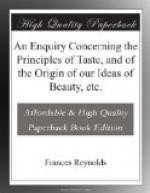I do not see that there is any objection to publishing the 3 letters, but I own I think Dr Johnson judges too lightly of the crime of forgery ... I believe the tenderness of sentiment Dr Johnson expresses for Dr Dodd in his afflictions will do him honour in the eyes of the Publick, & therefore as his friend you may with propriety publish the letters.[7]
Mrs. Montagu concluded, “I wish some name that would do more honour to your work was to appear in the dedication, but to be presented to the publick with such a mark of Mrs Reynolds’ friendly regard, will certainly be esteemed an honour....”
Sometime between February and July 1789 the Enquiry was reprinted, this time by J. Smeeton (copies of this version may be found in the Bodleian Library and the Library of Congress). The terminal date for the reprinting is established by the fact that the three letters of Johnson which were appended to the essay were reprinted without comment in the July issue of the European Magazine.
Just where Miss Reynolds secured copies of the Johnson letters is not certain. It is suggestive, however, that the letter to Banks had originally been sent under cover to Sir Joshua Reynolds and that Sir Joshua’s copy is now among the Boswell papers at Yale University. There would have been ample opportunity for Frances Reynolds also to have secured a copy. And the letter to Charles Jenkinson of 20 June 1777 and to Dr. Dodd of 26 June were of the sort that an enterprising lady might well have wheedled copies from the Doctor. The important point is that the inclusion of the letters in the 1789 printing of the Enquiry provides incontrovertible proof of Miss Reynolds’ connection with the piece.
For this second printing the entire pamphlet was reset, with numerous minor changes of wording and punctuation, but with no major alterations in meaning. In general the textual improvements are such as a bluestocking lady might well wish to make. It will be noted that on pages 25 and 49 of the copy here reproduced someone has made minor changes in wording in ink. These corrections are made in the later printing. Moreover, at the end of the 1789 version there is an errata list, indicating three alterations from the 1785 text which were mistakes. The Dedication remained unchanged, but the geometrical illustration was now placed facing the beginning of Chapter I.
The Enquiry was written in what is now recognized as one of the most exciting periods in the history of aesthetics, the late eighteenth century being a crucial point in the gradual shift from absolute classical standards to the relative approaches of the next age. Most of the important thinkers of the day—Hume, Burke, Lord Kames, Adam Smith, among others—were thinking deeply about the problem of taste. And if Miss Reynolds’ essay is not one of the most perceptive of the discussions, it is at least one of the liveliest.




